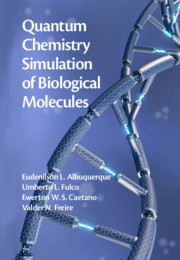Book contents
- Frontmatter
- Contents
- Preface
- Figure Credits
- 1 Basic Properties of Quantum Chemistry
- 2 Charge Transport in the DNA Molecule
- 3 Electronic Transmission Spectra of the DNA Molecule
- 4 Thermodynamic Properties of the DNA Molecule
- 5 Properties of the DNA/RNA Nucleobases
- 6 Molecular Electronics
- 7 Amino Acid Anhydrous Crystals
- 8 Protein–Protein Systems
- 9 Ascorbic Acid and Ibuprofen Drugs
- 10 Cholesterol-Lowering Drugs
- 11 Collagen-Based Biomaterials
- 12 Antimigraine Drugs
- 13 Antiparkinson Drugs
- 14 Central Nervous System Disorders
- 15 The Biology of Cancer
- 16 Concluding Remarks
- Bibliography
- Index
5 - Properties of the DNA/RNA Nucleobases
Published online by Cambridge University Press: 21 January 2021
- Frontmatter
- Contents
- Preface
- Figure Credits
- 1 Basic Properties of Quantum Chemistry
- 2 Charge Transport in the DNA Molecule
- 3 Electronic Transmission Spectra of the DNA Molecule
- 4 Thermodynamic Properties of the DNA Molecule
- 5 Properties of the DNA/RNA Nucleobases
- 6 Molecular Electronics
- 7 Amino Acid Anhydrous Crystals
- 8 Protein–Protein Systems
- 9 Ascorbic Acid and Ibuprofen Drugs
- 10 Cholesterol-Lowering Drugs
- 11 Collagen-Based Biomaterials
- 12 Antimigraine Drugs
- 13 Antiparkinson Drugs
- 14 Central Nervous System Disorders
- 15 The Biology of Cancer
- 16 Concluding Remarks
- Bibliography
- Index
Summary
The integration of DNA and RNA nucleobases to improve the performance of organic light-emitting diodes, as a low-cost and environmentally friendly optoelectronic device, has attracted a lot of interest in recent years. As a contribution to an improved understanding of the DNA/RNA-based devices in the solid state, we presented here a dispersion corrected density functional theory (DFT) and time-dependent DFT calculations to obtain the optimized geometries, Kohn-Sham band structures, charge distribution, optical absorption, Frenkel exciton binding energies, and complex dielectric functions of the five DNA/RNA nucleobases anhydrous crystals. Optical absorption measurements on the DNA/RNA nucleobase powders were also performed for comparison with the simulations. Effective masses for the carriers were calculated, indicating that the guanine and the cytosine crystals have potential applications in optoelectronics as a direct gap semiconductor, with the other nucleobases (adenine, thymine, and uracil) presenting either a semiconductor or an insulator character, depending on the carrier type.
Keywords
- Type
- Chapter
- Information
- Quantum Chemistry Simulation of Biological Molecules , pp. 117 - 136Publisher: Cambridge University PressPrint publication year: 2021



